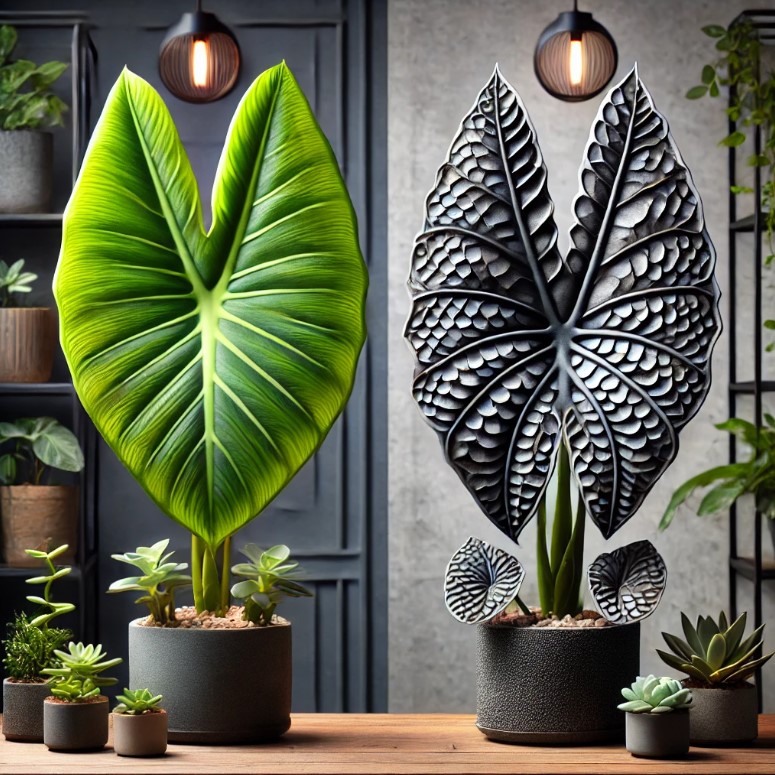Selecting the best type of Alocasia for adding a beautiful bold vibe to your indoor garden. The most beautiful and popular types are Elephant Ear Alocasia and Dragonscale Alocasia. They are large and striking, with unusual foliage making them popular attractions amongst plant lovers. In this article, we are going to break down the differences between these two stunning Alocasia varieties: Elephant Ear and Dragonscale. We will discuss their size and growth habit including how to care for a Philodendron or Monstera plant, so you can make an informed decision on which one is best suited to your home and horticultural skills.
Elephant Ear vs. Dragonscale Differences
To narrow down your choices between these two wonderful varieties, we are detailing their comparisons on the undermentioned factors:
1. Leaf Shape and Size
Elephant Ear: This plant of the arum family has massive heart-shaped leaves that look like an elephant’s ear.
Dragonscale: Smaller, textured leaves that resemble dragon scales and give it a more ornate appearance
2. Growth Habit
Elephant Ear: Generally more habit lots bigger, extra sprawling.
Dragonscale: This is more of an upright and compact grower, with a tidier growth habit.
3. Color and Texture
Elephant Ear: Large leaves with bright green and sleek.
Dragonscale – Similar but darker leaves that have a metallic look and texture, like dragon scales.
4. Care Requirements
Elephant Ear: Enjoys watered more often and humidity. Needs indirect sunlight.
Dragon scale:Needs a little less moisture than the above, can handle medium humidity and should be in bright indirect light.
5. Maintenance and Pruning
Elephant Ear: Will need to be pruned regularly as it gets large
Dragonscale: Low-maintenance; mostly just occasional clipping to maintain its shape.
6. Temperature Needs
Elephant Ear: Grows best in warmer weather and may need a controlled environment in cooler climates.
Dragonscale: Slightly more tolerant to different temperatures but favors a hot tropical climate.
7. Soil Preferences
Elephant Ear : Need well drained, fertile soil, with a pH level of 6.5 – 7
Dragonscale: Prefers slightly acidic, well-drained soils and thrives in soil high in organic matter.
8. Light Requirements
Elephant ear: Prefers indirect light, but can withstand direct light.
Dragonscale: Like a lot of light, bright but should be avoided from direct sunlight
9. Watering Needs
Water needs during the growing season: Elephant ear: Needs to be watered often
Dragonscale: Water when top inch of soil feels dry; do not let sit in water, or become root-bound.
10. Foliage Longevity
Elephant Ear: Great big, robust leaves (which will get even bigger!, but may fizzle in low light)
Dragonscale: for foliage, more consistent appearance over time with less visible degradation in lower light conditions}
11. Pest Resistance
Elephant Ear: Can have numerous pests such as aphids and mealybugs.
Dragonscale, mostly pest resistant but with regular inspections you can avoid trouble.
12. Toxicity to Pets
Elephant Ear: Poisonous to pets (and in particular cats and dogs).
Dragonscale: Also poisonous to pets and thus must be taken away from curious animals.
13. Ideal Potting Conditions
Elephant Ear: The fast-growing root system and big leaves require a large pot.
Dragonscale: It needs room for its roots to grow but can be grown in a bit smaller pot.
14. Flowering Capabilities
Elephant Ear: Pretty much never flowers indoors, but with just the right setting it might happen.
Dragonscale – Rarely flowers indoors, but some specimens may bloom with proper care.
15. Cost and Availability
Elephant Ear: Usually cheaper and more commonly found in garden centers or online.
Disclaimer: dragonscale is slightly pricier, and some are flamboyantly nicknamed the house plant of a serious collector (which may only be purchased online).
How To Choose Your Alocasia?
Whether you should go for Elephant Ear Alocasia or Dragonscale Alocasia depends on your individual needs, where your home is situated and the look that you are after. For something a bit bigger and more spectacle-like, the heart shapes leaves of the Elephant Ear are hard to beat. If, however, you want a plant that is smaller, more formal in shape with very fine dark leaves and an interesting texture then the Dragonscale might be more suitable.
Both types are great to grow indoors and will be a beautiful part of any plant collection. Before you buy, make sure information you will require for light water and area. Alocasia plants belong to the Araceae family and are indigenous to tropical areas in Vietnam and Southeast Asia. These tropical plants are a popular choice for home or office spaces because of their large, colorful leaves with detailed patterns. Among the most popular types is Alocasia Polly, with its dark green leaves and prominent veins; some, such as Alocasia Frydek, have velvet-y textures. Learn more about this genus so you can care for it better!.Alocasians like a bright, indirect light. They don’t do well in direct sun, and can easily burn their foliage. One of the most important steps to taking care of your Alocasia is finding the right spot—preferably a place on a windowsill with sheer curtains, or east or west-facing window. Artificial grow lights could be required to maintain the plant healthy in darker areas.
